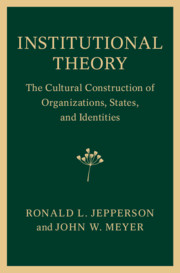Book contents
- Institutional Theory
- Institutional Theory
- Copyright page
- Contents
- Figures
- Preface
- Credits
- Part I Introduction
- Part II Institutional Theory: Its Role in Modern Social Analysis
- 2 Society without Culture:
- 3 Institutions, Institutional Effects, and Institutionalism (1991)
- 4 The Development and Application of Sociological Neoinstitutionalism (2002)
- 5 Reflections on Part II:
- Part III The Institutional Level of Analysis
- Part IV Institutions of Modernity and Postmodernity: The Construction of Actors
- Part V Conclusion
- Index
- References
3 - Institutions, Institutional Effects, and Institutionalism (1991)
from Part II - Institutional Theory: Its Role in Modern Social Analysis
Published online by Cambridge University Press: 22 March 2021
- Institutional Theory
- Institutional Theory
- Copyright page
- Contents
- Figures
- Preface
- Credits
- Part I Introduction
- Part II Institutional Theory: Its Role in Modern Social Analysis
- 2 Society without Culture:
- 3 Institutions, Institutional Effects, and Institutionalism (1991)
- 4 The Development and Application of Sociological Neoinstitutionalism (2002)
- 5 Reflections on Part II:
- Part III The Institutional Level of Analysis
- Part IV Institutions of Modernity and Postmodernity: The Construction of Actors
- Part V Conclusion
- Index
- References
Summary
Clarification of the ideas of institution, institutionalization, and institutionalism.Conceives of institutions as controlling patterns of widely varying sorts, relevant to the explanation of, and stabilization of, the behavior of the full range of modern actors.
- Type
- Chapter
- Information
- Institutional TheoryThe Cultural Construction of Organizations, States, and Identities, pp. 37 - 66Publisher: Cambridge University PressPrint publication year: 2021
References
- 10
- Cited by

